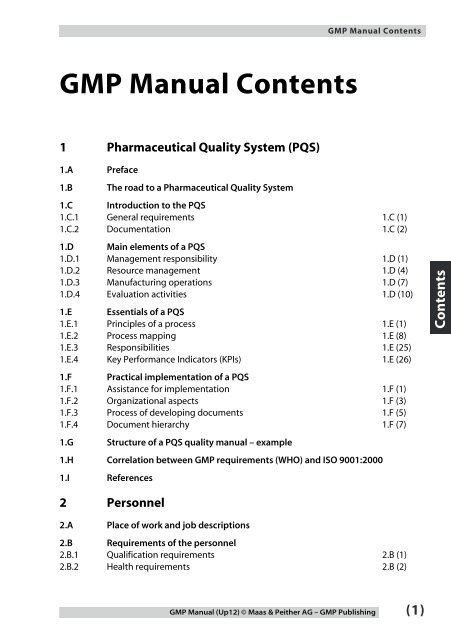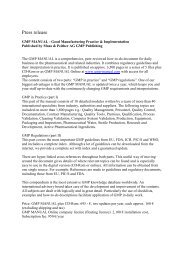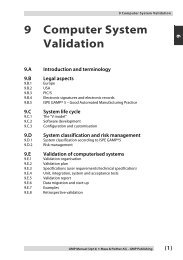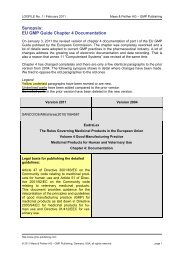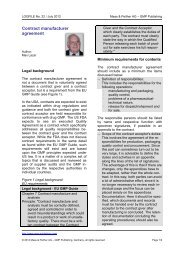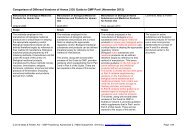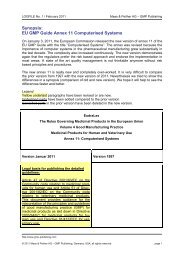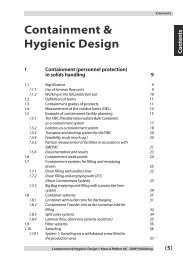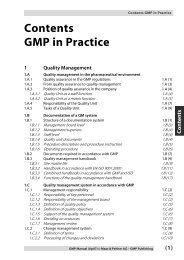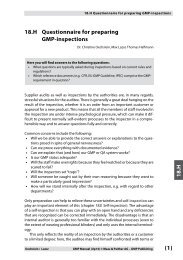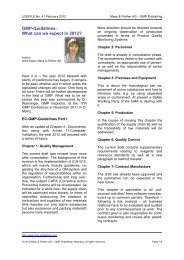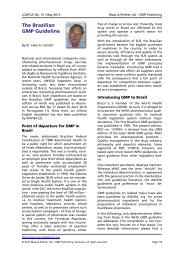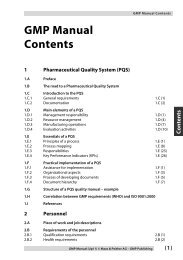GMP Manual Contents - GMP cGMP
GMP Manual Contents - GMP cGMP
GMP Manual Contents - GMP cGMP
Create successful ePaper yourself
Turn your PDF publications into a flip-book with our unique Google optimized e-Paper software.
<strong>GMP</strong> <strong>Manual</strong> <strong>Contents</strong><br />
<strong>GMP</strong> <strong>Manual</strong> <strong>Contents</strong><br />
1 Pharmaceutical Quality System (PQS)<br />
1.A Preface<br />
1.B The road to a Pharmaceutical Quality System<br />
1.C Introduction to the PQS<br />
1.C.1 General requirements 1.C (1)<br />
1.C.2 Documentation 1.C (2)<br />
1.D Main elements of a PQS<br />
1.D.1 Management responsibility 1.D (1)<br />
1.D.2 Resource management 1.D (4)<br />
1.D.3 Manufacturing operations 1.D (7)<br />
1.D.4 Evaluation activities 1.D (10)<br />
1.E Essentials of a PQS<br />
1.E.1 Principles of a process 1.E (1)<br />
1.E.2 Process mapping 1.E (8)<br />
1.E.3 Responsibilities 1.E (25)<br />
1.E.4 Key Performance Indicators (KPIs) 1.E (26)<br />
1.F Practical implementation of a PQS<br />
1.F.1 Assistance for implementation 1.F (1)<br />
1.F.2 Organizational aspects 1.F (3)<br />
1.F.3 Process of developing documents 1.F (5)<br />
1.F.4 Document hierarchy 1.F (7)<br />
1.G Structure of a PQS quality manual – example<br />
1.H Correlation between <strong>GMP</strong> requirements (WHO) and ISO 9001:2000<br />
1.I References<br />
<strong>Contents</strong><br />
2 Personnel<br />
2.A Place of work and job descriptions<br />
2.B Requirements of the personnel<br />
2.B.1 Qualification requirements 2.B (1)<br />
2.B.2 Health requirements 2.B (2)<br />
<strong>GMP</strong> <strong>Manual</strong> (Up12) © Maas & Peither AG – <strong>GMP</strong> Publishing<br />
(1)
<strong>GMP</strong> <strong>Manual</strong> <strong>Contents</strong><br />
2.C Training<br />
2.C.1 Purpose of training 2.C (1)<br />
2.C.2 Responsibility for training 2.C (1)<br />
2.C.3 Requirements profiles/learning objectives 2.C (2)<br />
2.C.4 Training contents and target groups 2.C (3)<br />
2.C.5 Training planning 2.C (4)<br />
2.C.6 Carrying out 2.C (4)<br />
2.C.7 Reviewing the training and the training system 2.C (8)<br />
2.C.8 Documentation 2.C (11)<br />
2.D Function owners subject to public law<br />
2.D.1 Qualified Person (QP) 2.D (1)<br />
2.D.2 Head of Production 2.D (12)<br />
2.D.3 Head of Quality Control 2.D (17)<br />
2.D.4 Qualified Person in Accordance with<br />
Article 103 of Guideline 2001/83/EC 2.D (21)<br />
2.D.5 Scientific Service in Charge of Information 2.D (24)<br />
2.D.6 Medical sales representatives 2.D (26)<br />
<strong>Contents</strong><br />
3 Premises<br />
3.A Official Requirements<br />
3.A.1 Location, connection to other rooms 3.A (4)<br />
3.A.2 Size, area, height 3.A (5)<br />
3.A.3 Installation and supply of utilities 3.A (7)<br />
3.A.4 Lighting, ventilation, air-conditioning 3.A (7)<br />
3.A.5 Hygienic construction 3.A (8)<br />
3.A.6 Room book and layout 3.A (8)<br />
3.B Material flow, personnel flow and layout<br />
3.B.1 Material flow 3.B (1)<br />
3.B.2 Personnel flow 3.B (4)<br />
3.B.3 Layout 3.B (4)<br />
3.B.4 Design concepts in FDA’s Sterile Drug Products<br />
Produced by Aseptic Processing guideline 3.B (5)<br />
3.C Room classes<br />
3.C.1 General <strong>GMP</strong> Requirements for Premises 3.C (1)<br />
3.C.2 <strong>GMP</strong> Requirements for Cleanrooms: Air Cleanliness Grades 3.C (1)<br />
3.C.3 Corresponding FDA Determinations 3.C (4)<br />
3.C.4 <strong>GMP</strong> Requirements for Premises 3.C (6)<br />
3.C.5 Room-specific Allocation of Air Cleanliness Stipulations 3.C (7)<br />
3.C.6 Cleanliness Zoning Concepts 3.C (9)<br />
3.C.7 Converting <strong>GMP</strong> Stipulations into Reality 3.C (12)<br />
(2)<br />
<strong>GMP</strong> <strong>Manual</strong> (Up12) © Maas & Peither AG – <strong>GMP</strong> Publishing
<strong>GMP</strong> <strong>Manual</strong> <strong>Contents</strong><br />
3.D Construction elements<br />
3.D.1 Walls 3.D (1)<br />
3.D.2 Doors and windows 3.D (6)<br />
3.D.3 Floors 3.D (8)<br />
3.D.4 Ceilings 3.D (10)<br />
3.E Barrier systems and isolators<br />
3.E.1 Protection concepts for maximized sterility assurance 3.E (1)<br />
3.E.2 Pharmaceutical isolator technology 3.E (2)<br />
3.E.3 Restricted access barrier systems (RABS technology) 3.E (8)<br />
3.E.4 Application options for RABS and isolators 3.E (12)<br />
3.F Building services<br />
3.F.1 Basic requirements for installation 3.F (1)<br />
3.F.2 Heating 3.F (3)<br />
3.F.3 Sanitary plumbing and sewage 3.F (3)<br />
3.F.4 Electrical installations incl. IT-management and control systems 3.F (3)<br />
3.F.5 Qualification 3.F (4)<br />
3.G Heating Ventilation Air Conditioning (HVAC)<br />
3.G.1 Introduction 3.G (1)<br />
3.G.2 Room ventilation systems 3.G (3)<br />
3.G.3 Filters 3.G (11)<br />
3.G.4 Principles for the design and planning of air<br />
conditioning ventilation systems 3.G (23)<br />
3.G.5 Design criteria for the ventilation of premises 3.G (26)<br />
3.G.6 Maintenance of air ventilation systems 3.G (37)<br />
3.H Process Gases<br />
3.H.1 Quality Requirements 3.H (2)<br />
3.H.2 Generation, Storage and Distribution 3.H (4)<br />
3.H.3 System design 3.H (5)<br />
3.H.4 Qualification and monitoring 3.H (8)<br />
3.I Qualification of premises and air-conditioning systems<br />
3.I.1 Objectives of qualification 3.I (1)<br />
3.I.2 Regulatory and normative fundamentals of qualification 3.I (2)<br />
3.I.3 Project development and qualification 3.I (3)<br />
3.I.4 Qualification Master Plan 3.I (4)<br />
3.I.5 Qualification Plans and Qualification Reports 3.I (5)<br />
3.I.6 Qualification checklists 3.I (6)<br />
3.I.7 Requirements for measurement and test reports 3.I (29)<br />
3.I.8 Requalification 3.I (30)<br />
3.J Monitoring of HVAC systems<br />
3.J.1 Objectives of process monitoring 3.J (1)<br />
3.J.2 Data management stipulations 3.J (1)<br />
3.J.3 Air cleanliness and other room air data 3.J (3)<br />
<strong>Contents</strong><br />
<strong>GMP</strong> <strong>Manual</strong> (Up12) © Maas & Peither AG – <strong>GMP</strong> Publishing<br />
(3)
<strong>GMP</strong> <strong>Manual</strong> <strong>Contents</strong><br />
3.J.4 Risks of microbiological monitoring 3.J (4)<br />
3.J.5 Alarm and action limits 3.J (4)<br />
3.J.6 Operation and maintenance 3.J (5)<br />
3.K References<br />
4 Facilities and Equipment<br />
<strong>Contents</strong><br />
4.A Introduction<br />
4.B Mechanical components<br />
4.B.1 Construction and installation materials 4.B (1)<br />
4.B.2 <strong>GMP</strong>-compliant design characteristics 4.B (2)<br />
4.B.3 Electrical and pneumatic components 4.B (3)<br />
4.C Control<br />
4.D Facility concepts<br />
4.D.1 CIP (Cleaning in Place) 4.D (1)<br />
4.D.2 Isolator technology 4.D (2)<br />
4.D.3 Connected facilities 4.D (2)<br />
4.E Examples of facility qualification<br />
4.E.1 Design qualification 4.E (1)<br />
4.E.2 Installation qualification 4.E (5)<br />
4.E.3 Operational qualification 4.E (12)<br />
4.F Technical documentation<br />
4.F.1 Necessity 4.F (1)<br />
4.F.2 Scope and content 4.F (2)<br />
4.F.3 Administration of the technical documentation 4.F (9)<br />
4.F.4 Log book 4.F (12)<br />
4.G Calibration<br />
4.G.1 Definitions 4.G (1)<br />
4.G.2 Procedure 4.G (3)<br />
4.G.3 Documentation 4.G (4)<br />
4.G.4 Administration of scheduled calibration dates/ times 4.G (5)<br />
4.H Maintenance<br />
4.H.1 Types of maintenance 4.H (2)<br />
4.H.2 <strong>GMP</strong>-conforming maintenance 4.H (2)<br />
4.H.3 Systems for maintenance 4.H (3)<br />
4.I CIP (Cleaning in Place)<br />
4.I.1 Introduction 4.I (1)<br />
4.I.2 CIP systems 4.I (3)<br />
4.I.3 <strong>GMP</strong>-conforming design of CIP facilities 4.I (6)<br />
4.I.4 Nozzle heads for container cleaning 4.I (11)<br />
(4)<br />
<strong>GMP</strong> <strong>Manual</strong> (Up12) © Maas & Peither AG – <strong>GMP</strong> Publishing
<strong>GMP</strong> <strong>Manual</strong> <strong>Contents</strong><br />
4.I.5 Measuring technology 4.I (13)<br />
4.I.6 Realisation of cleaning systems 4.I (15)<br />
4.J Containment (personnel protection)<br />
in solids handling<br />
4.J.1 Significance 4.J (1)<br />
4.J.2 Definition of terms 4.J (3)<br />
4.J.3 Containment grades of products 4.J (3)<br />
4.J.4 Measurement of the residue limits (OEL) 4.J (6)<br />
4.J.5 Example of containment facility planning 4.J (7)<br />
4.J.6 Containment weak points 4.J (15)<br />
4.J.7 Containment systems for filling and emptying drums 4.J (16)<br />
4.J.8 Container systems 4.J (23)<br />
4.J.9 Filter systems 4.J (27)<br />
4.J.10 Sampling 4.J (28)<br />
4.J.11 Containment on equipment 4.J (30)<br />
4.K Process control systems<br />
4.K.1 Definitions 4.K (1)<br />
4.K.2 Features of process control systems 4.K (2)<br />
4.K.3 How to use process control systems 4.K (5)<br />
4.K.4 Carrying out a process control system project 4.K (6)<br />
4.K.5 Qualification of process control systems 4.K (7)<br />
4.L Hygienic (sanitary) design when using solids<br />
4.L.1 Introduction 4.L (1)<br />
4.L.2 Surfaces 4.L (3)<br />
4.L.3 Material: stainless steel 4.L (6)<br />
4.L.4 Connections 4.L (11)<br />
4.L.5 Hoists and roller conveyors 4.L (22)<br />
4.L.6 Pneumatic conveyor system 4.L (25)<br />
4.L.7 Dosing systems 4.L (26)<br />
4.L.8 Platforms and stands 4.L (28)<br />
4.L.9 Clean room installations 4.L (31)<br />
<strong>Contents</strong><br />
5 Pharmaceutical Water<br />
5.A Water types<br />
5.A.1 Potable water 5.A (2)<br />
5.A.2 Purified water 5.A (3)<br />
5.A.3 Highly purified water 5.A (5)<br />
5.A.4 Water for injection 5.A (7)<br />
5.B Generation of pharmaceutical water<br />
5.B.1 Purified water (PW) 5.B (2)<br />
5.B.2 Water for injection (WFI) 5.B (11)<br />
5.B.3 Purification of pharmaceutical water treatment systems 5.B (14)<br />
<strong>GMP</strong> <strong>Manual</strong> (Up12) © Maas & Peither AG – <strong>GMP</strong> Publishing<br />
(5)
<strong>GMP</strong> <strong>Manual</strong> <strong>Contents</strong><br />
<strong>Contents</strong><br />
5.C Distribution and storage of pharmaceutical water<br />
5.C.1 Loop 5.C (1)<br />
5.C.2 Fixtures 5.C (6)<br />
5.C.3 Measuring technique 5.C (7)<br />
5.C.4 Formation of biofilms 5.C (21)<br />
5.C.5 Rouging 5.C (23)<br />
5.C.6 Buffering of ultra pure water 5.C (27)<br />
5.C.7 Loop with subloops 5.C (29)<br />
5.D Qualification of water supplies<br />
5.D.1 Introduction 5.D (1)<br />
5.D.2 Risk analysis 5.D (3)<br />
5.D.3 Design qualification 5.D (8)<br />
5.D.4 Installation qualification 5.D (17)<br />
5.D.5 Operational qualification (OQ) 5.D (28)<br />
5.D.6 Transfer to the user 5.D (36)<br />
5.D.7 Process validation/performance qualification (PQ) 5.D (42)<br />
5.D.8 Qualification report 5.D (47)<br />
5.E Operation of water supplies<br />
5.E.1 Procedures to reduce microbial counts 5.E (1)<br />
5.E.2 Maintenance of a water supply 5.E (4)<br />
5.E.3 Calibration of measuring systems 5.E (10)<br />
5.E.4 Change control 5.E (11)<br />
5.E.5 Requalification 5.E (13)<br />
5.E.6 Decommissioning/uninstalling 5.E (14)<br />
5.F Pure steam systems<br />
5.F.1 Physical principles 5.F (1)<br />
5.F.2 Quality requirements for pure steam 5.F (3)<br />
5.F.3 Pure steam generation 5.F (6)<br />
5.F.4 Pure steam distribution system 5.F (10)<br />
6 Qualification<br />
6.A Official requirements<br />
6.A.1 Legal aspects of qualification 6.A (1)<br />
6.A.2 Documentation of the qualification 6.A (4)<br />
6.A.3 Design Qualification (DQ) 6.A (5)<br />
6.A.4 Installation Qualification (IQ) 6.A (8)<br />
6.A.5 Operational Qualification (OQ) 6.A (9)<br />
6.A.6 Performance Qualification (PQ) 6.A (10)<br />
6.A.7 Qualification of established facilities 6.A (11)<br />
6.A.8 Requalification 6.A (13)<br />
(6)<br />
<strong>GMP</strong> <strong>Manual</strong> (Up12) © Maas & Peither AG – <strong>GMP</strong> Publishing
<strong>GMP</strong> <strong>Manual</strong> <strong>Contents</strong><br />
6.B Preparation of the qualification<br />
6.B.1 Commissioning 6.B (1)<br />
6.B.2 Sequence 6.B (5)<br />
6.B.3 Qualification team 6.B (6)<br />
6.B.4 Responsibilities 6.B (6)<br />
6.B.5 Qualification by external service providers 6.B (6)<br />
6.B.6 Risk analysis 6.B (10)<br />
6.C Qualification documentation<br />
6.C.1 Qualification master plan 6.C (2)<br />
6.C.2 Qualification plan 6.C (3)<br />
6.C.3 Qualification report 6.C (9)<br />
6.C.4 Labeling of the qualification status 6.C (10)<br />
6.C.5 SOP – “Qualification of facilities and equipment” 6.C (11)<br />
6.D Design qualification (DQ)<br />
6.D.1 User requirements (user specifications) 6.D (3)<br />
6.D.2 Technical specification 6.D (12)<br />
6.E Installation qualification (IQ)<br />
6.E.1 Examples of IQ plans 6.E (3)<br />
6.E.2 Example: Fluid bed equipment 6.E (22)<br />
6.F Operational qualification(OQ)<br />
6.F.1 Examples of OQ plans 6.F (3)<br />
6.F.2 Example: Fluid bed dryer 6.F (13)<br />
6.G Performance qualification (PQ)<br />
6.H Special cases of qualification<br />
6.H.1 Retrospective qualification 6.H (1)<br />
6.H.2 Requalification 6.H (2)<br />
6.H.3 Content of a review 6.H (3)<br />
6.H.4 Maintenance of the qualified status 6.H (5)<br />
6.H.5 Qualification of simple equipment 6.H (7)<br />
<strong>Contents</strong><br />
7 Process Validation<br />
7.A Official requirements<br />
7.A.1 Regulative aspects 7.A (1)<br />
7.A.2 Principles of process validation 7.A (11)<br />
7.A.3 Types of process validation 7.A (18)<br />
7.A.4 Maintaining the validated status 7.A (23)<br />
7.A.5 Documentation of process validation 7.A (27)<br />
7.B Validation – a key element of quality management<br />
7.B.1 What is the significance of validation 7.B (1)<br />
7.B.2 How is validation defined 7.B (2)<br />
<strong>GMP</strong> <strong>Manual</strong> (Up12) © Maas & Peither AG – <strong>GMP</strong> Publishing<br />
(7)
<strong>GMP</strong> <strong>Manual</strong> <strong>Contents</strong><br />
<strong>Contents</strong><br />
7.B.3 Who must perform validation 7.B (2)<br />
7.B.4 What faults can occur during validation 7.B (3)<br />
7.B.5 What are the benefits of validation 7.B (4)<br />
7.B.6 Current trends in process validation 7.B (5)<br />
7.B.7 Process validation from the viewpoint of the FDA 7.B (5)<br />
7.C Validation planning and procedure<br />
7.C.1 Process validation approaches 7.C (1)<br />
7.C.2 Prerequisites and responsibilities 7.C (8)<br />
7.C.3 Scope of Validation 7.C (21)<br />
7.D Validation documentation<br />
7.D.1 Structure and archiving 7.D (1)<br />
7.D.2 Validation master plan 7.D (3)<br />
7.D.3 Validation protocol 7.D (8)<br />
7.D.4 Validation report 7.D (19)<br />
7.D.5 Documentation examples 7.D (22)<br />
7.E Process Validation and Product Lifecycle<br />
7.E.1 Quality by Design 7.E (2)<br />
7.E.2 Process Analytical Technology (PAT) 7.E (11)<br />
7.E.3 Maintaining the validated state 7.E (18)<br />
7.E.4 Process validation as a three-stage life cycle model 7.E (30)<br />
7.F References<br />
8 Cleaning Validation<br />
8.A Official requirements<br />
8.B How to validate cleaning procedures<br />
8.B.1 Optimization of cleaning procedures 8.B (1)<br />
8.B.2 Compilation of cleaning instructions 8.B (5)<br />
8.B.3 Validating manual and automated cleaning procedures 8.B (8)<br />
8.C Cleaning validation master plan<br />
8.D Establishing the scope of validation<br />
8.D.1 Bracketing: determination of critical substances 8.D (1)<br />
8.D.2 Matrixing: determination of equipment-specific validation protocols 8.D (5)<br />
8.E Acceptance criteria and limit calculation<br />
8.E.1 Calculation of active pharmaceutical ingredient residues 8.E (1)<br />
8.E.2 Calculation of cleansing agent residues 8.E (10)<br />
8.E.3 Determination of the microbial status 8.E (11)<br />
8.F Sampling procedures<br />
8.F.1 Swab test 8.F (1)<br />
8.F.2 Rinse test 8.F (4)<br />
8.F.3 Other procedures 8.F (6)<br />
(8)<br />
<strong>GMP</strong> <strong>Manual</strong> (Up12) © Maas & Peither AG – <strong>GMP</strong> Publishing
<strong>GMP</strong> <strong>Manual</strong> <strong>Contents</strong><br />
8.F.4 Selection of the appropriate sampling procedure 8.F (7)<br />
8.F.5 Microbiological testing of surfaces 8.F (9)<br />
8.G Analytical procedures<br />
8.G.1 Requirements for method validation 8.G (1)<br />
8.G.2 Selection of the appropriate analytical procedure 8.G (6)<br />
8.H Documentation<br />
8.H.1 Validation protocol 8.H (1)<br />
8.H.2 Validation report 8.H (5)<br />
8.H.3 Other documents 8.H (7)<br />
8.I Maintenance of the validated status<br />
8.I.1 Changes and deviations 8.I (2)<br />
8.I.2 Change control 8.I (3)<br />
8.I.3 Revalidation 8.I (4)<br />
8.I.4 New products and equipment 8.I (9)<br />
8.I.5 Deviations 8.I (12)<br />
8.J Cleaning validation documentation (example)<br />
8.K References<br />
9 Computer System Validation<br />
9.A Introduction and terminology<br />
9.B Legal aspects<br />
9.B.1 Europe 9.B (1)<br />
9.B.2 USA 9.B (4)<br />
9.B.3 PIC/S 9.B (6)<br />
9.B.4 Electronic signatures and electronic records 9.B (6)<br />
9.B.5 ISPE GAMP® 5 – Good Automated Manufacturing Practice 9.B (8)<br />
9.C System life cycle<br />
9.C.1 The “V model” 9.C (2)<br />
9.C.2 Software development 9.C (5)<br />
9.C.3 Configuration and customisation 9.C (7)<br />
9.D System classification and risk management<br />
9.D.1 System classification according to ISPE GAMP®5 9.D (1)<br />
9.D.2 Risk management 9.D (6)<br />
9.E Validation of computerised systems<br />
9.E.1 Validation organisation 9.E (2)<br />
9.E.2 Validation plan 9.E (4)<br />
9.E.3 Specifications (user requirements/technical specification) 9.E (6)<br />
9.E.4 Unit, integration, system and acceptance tests 9.E (9)<br />
9.E.5 Validation report 9.E (16)<br />
9.E.6 Data migration and start-up 9.E (16)<br />
<strong>GMP</strong> <strong>Manual</strong> (Up12) © Maas & Peither AG – <strong>GMP</strong> Publishing<br />
(9)<br />
<strong>Contents</strong>
<strong>GMP</strong> <strong>Manual</strong> <strong>Contents</strong><br />
<strong>Contents</strong><br />
9.E.7 Examples 9.E (18)<br />
9.E.8 Retrospective validation 9.E (24)<br />
9.F Operation of computerised systems<br />
9.F.1 System description 9.F (1)<br />
9.F.2 User training 9.F (1)<br />
9.F.3 Standard operating procedures (SOPs) 9.F (1)<br />
9.F.4 Access and security 9.F (2)<br />
9.F.5 Data backup and archiving 9.F (4)<br />
9.F.6 Contingency plans 9.F (5)<br />
9.F.7 Change management and error reporting 9.F (7)<br />
9.F.8 Periodic review 9.F (9)<br />
9.F.9 Retirement of computerised systems 9.F (9)<br />
9.G External service providers<br />
9.G.1 Relocation of activities 9.G (1)<br />
9.G.2 Service level agreement 9.G (2)<br />
9.G.3 Auditing of suppliers and service providers 9.G (8)<br />
9.H References<br />
10 Considerations on Risk Management<br />
10.A Introduction and Principles<br />
10.A.1 Advantages of Risk Management 10.A (2)<br />
10.A.2 Considerations on the Risk-Based Approach 10.A (4)<br />
10.A.3 Regulatory Environment 10.A (7)<br />
10.A.4 Objectives 10.A (12)<br />
10.A.5 Science-Based Approach 10.A (13)<br />
10.A.6 Summary 10.A (14)<br />
10.B Basic Consideration on Implementing Risk Management Into a Process<br />
10.B.1 Areas of Hazards 10.B (1)<br />
10.B.2 Prerequisites 10.B (3)<br />
10.B.3 Use of Knowledge and Experience 10.B (5)<br />
10.B.4 Consideration on <strong>Manual</strong> Operations 10.B (5)<br />
10.B.5 Elements of Risk Management 10.B (6)<br />
10.B.6 Implementation of a Risk Management Process 10.B (7)<br />
10.B.7 Commitment of Management 10.B (7)<br />
10.B.8 Project Team 10.B (8)<br />
10.B.9 Analysis of Existing Risk Management Approaches 10.B (8)<br />
10.B.10 Standardization of Methods and Tools 10.B (9)<br />
10.B.11 Considerations on Risk Based Behavior 10.B (9)<br />
10.B.12 Additional Training Required 10.B (10)<br />
(10)<br />
<strong>GMP</strong> <strong>Manual</strong> (Up12) © Maas & Peither AG – <strong>GMP</strong> Publishing
<strong>GMP</strong> <strong>Manual</strong> <strong>Contents</strong><br />
10.C Details on Using Risk Management Principles as Behavior<br />
10.C.1 Application to the QM System 10.C (1)<br />
10.C.2 The Team 10.C (2)<br />
10.C.3 Assessment Criteria 10.C (3)<br />
10.C.4 Procedure to Determine Conclusions 10.C (4)<br />
10.C.5 Evaluation on Individual Topics (Detailed<br />
Evaluation) Using Risk Management 10.C (4)<br />
10.C.6 Example on Process Validation 10.C (6)<br />
10.D Methodologies to be Used to Facilitate Risk Management<br />
10.E Using Process Mapping<br />
10.F Using a Fishbone Diagram<br />
10.F.1 Create a Fish Bone Diagram 10.F (2)<br />
10.F.2 Advantages and Disadvantages 10.F (4)<br />
10.G Informal Use of Risk Management<br />
10.H Fault Tree Analysis (FTA)<br />
10.H.1 Basic Principles 10.H (1)<br />
10.H.2 Objective: What a FTA Can Do and Where to Use It 10.H (1)<br />
10.H.3 How to Run the Process of a FTA 10.H (2)<br />
10.H.4 Prerequisites for an FTA 10.H (2)<br />
10.H.5 Execution of an FTA 10.H (3)<br />
10.H.6 Advantages and Disadvantages of an FTA 10.H (5)<br />
10.I Failure Mode Effects Analysis (FMEA)<br />
10.I.1 Objectives and Areas of Application 10.I (2)<br />
10.I.2 General Items on the FMEA Process 10.I (3)<br />
10.I.3 Implementation of FMEA in a Project 10.I (18)<br />
10.I.4 Advantages and Disadvantages of an FMEA 10.I (18)<br />
10.I.5 Application Example of a Modified FMEA 10.I (23)<br />
10.J Hazard Analysis of Critical Control Points (HACCP)<br />
10.J.1 Prerequisite and Result to be Expected 10.J (2)<br />
10.J.2 Advantages and Disadvantages 10.J (8)<br />
10.J.3 Application Example 10.J (9)<br />
10.K Conclusion<br />
<strong>Contents</strong><br />
11 Production<br />
11.A Sanitation<br />
11.A.1 Organisational prerequisites 11.A (1)<br />
11.A.2 Sources of contamination 11.A (2)<br />
11.A.3 Responsibilities and implementation 11.A (3)<br />
<strong>GMP</strong> <strong>Manual</strong> (Up12) © Maas & Peither AG – <strong>GMP</strong> Publishing<br />
(11)
<strong>GMP</strong> <strong>Manual</strong> <strong>Contents</strong><br />
<strong>Contents</strong><br />
11.B Personnel hygiene<br />
11.B.1 Clothing 11.B (1)<br />
11.B.2 Code of Conduct 11.B (11)<br />
11.B.3 Hand disinfection 11.B (14)<br />
11.B.4 Health requirements 11.B (15)<br />
11.B.5 Training 11.B (16)<br />
11.C Production hygiene<br />
11.C.1 Sources of contamination 11.C (4)<br />
11.C.2 Cleaning 11.C (11)<br />
11.C.3 Disinfection 11.C (13)<br />
11.D Sanitation programme<br />
11.D.1 Organisation of room cleaning 11.D (1)<br />
11.D.2 Documentation 11.D (5)<br />
11.E Environmental monitoring<br />
11.E.1 General 11.E (1)<br />
11.E.2 Sampling plan 11.E (3)<br />
11.E.3 Establishment of limits and frequencies 11.E (4)<br />
11.E.4 Methods 11.E (9)<br />
11.E.5 Investigation areas 11.E (11)<br />
11.E.6 Evaluation 11.E (16)<br />
11.F <strong>GMP</strong> in the production process<br />
11.G Weigh-in<br />
11.G.1 Legal requirements 11.G (1)<br />
11.G.2 Weigh-in principles 11.G (3)<br />
11.G.3 Weigh-in procedure 11.G (7)<br />
11.G.4 Documentation 11.G (11)<br />
11.H Identification<br />
11.H.1 Handling of labels 11.H (1)<br />
11.H.2 Labelling of starting materials 11.H (2)<br />
11.H.3 Labelling of equipment and containers 11.H (3)<br />
11.H.4 Labelling of rooms 11.H (7)<br />
11.I In-process control<br />
11.I.1 Objectives 11.I (2)<br />
11.I.2 Organisation and responsibilities 11.I (3)<br />
11.I.3 Carrying out 11.I (4)<br />
11.I.4 Documentation and evaluation of data 11.I (8)<br />
11.J Prevention of cross-contamination<br />
11.J.1 Causes of cross-contamination 11.J (1)<br />
11.J.2 Measures to prevent cross-contamination 11.J (5)<br />
11.J.3 Manufacture of critical products 11.J (6)<br />
(12)<br />
<strong>GMP</strong> <strong>Manual</strong> (Up12) © Maas & Peither AG – <strong>GMP</strong> Publishing
<strong>GMP</strong> <strong>Manual</strong> <strong>Contents</strong><br />
11.K Deviations<br />
11.K.1 Definition 11.K (1)<br />
11.K.2 Procedure 11.K (2)<br />
11.K.3 Responsibilities 11.K (4)<br />
11.K.4 Measures 11.K (4)<br />
11.K.5 Failure investigation report 11.K (5)<br />
11.K.6 Evaluation of measures 11.K (7)<br />
11.K.7 SOP “deviations” – (example) 11.K (9)<br />
11.K.8 Check-list for deviation handling 11.K (14)<br />
11.L Reworking<br />
11.L.1 Definitions 11.L (1)<br />
11.L.2 Procedure 11.L (2)<br />
11.L.3 Rework / Reprocessing of rejected products 11.L (4)<br />
11.L.4 Rework of returned products 11.L (8)<br />
11.L.5 Rework of products that have not been rejected 11.L (8)<br />
11.M Warehouse and logistics<br />
11.M.1 Regulatory requirements 11.M (1)<br />
11.M.2 Stock management system 11.M (2)<br />
11.M.3 Responsibilities 11.M (6)<br />
11.M.4 Personnel 11.M (6)<br />
11.M.5 Storage areas 11.M (7)<br />
11.M.6 Storage conditions 11.M (13)<br />
11.M.7 Sanitation and pest control 11.M (16)<br />
11.M.8 Material Flow 11.M (18)<br />
11.M.9 Process Flow 11.M (22)<br />
11.N Transportation<br />
11.N.1 Requirements for logistic service providers 11.N (2)<br />
11.N.2 Transportation challenges and monitoring devices 11.N (5)<br />
11.N.3 Cool/Cold Chain Distribution 11.N (9)<br />
11.N.4 Temperature Profiles 11.N (13)<br />
11.N.5 Transportation Risks 11.N (18)<br />
11.O References<br />
<strong>Contents</strong><br />
12 Sterile Production<br />
12.A Introduction<br />
12.A.1 Manufacturing products that can be sterilised in the final container 12.A (2)<br />
12.A.2 Aseptic processing 12.A (3)<br />
12.A.3 Production areas/premises 12.A (4)<br />
12.A.4 Production equipment 12.A (7)<br />
12.B Air Lock Concepts<br />
12.B.1 Personnel locks in the clean area 12.B (1)<br />
12.B.2 Material locks 12.B (7)<br />
<strong>GMP</strong> <strong>Manual</strong> (Up12) © Maas & Peither AG – <strong>GMP</strong> Publishing<br />
(13)
<strong>GMP</strong> <strong>Manual</strong> <strong>Contents</strong><br />
<strong>Contents</strong><br />
12.C Manufacturing the solution<br />
12.C.1 Starting materials 12.C (1)<br />
12.C.2 Solution batch 12.C (4)<br />
12.C.3 Testing the bioburden 12.C (8)<br />
12.C.4 Sterile filtration 12.C (9)<br />
12.D Washing processes<br />
12.D.1 Stoppers 12.D (1)<br />
12.D.2 Particulate impurities 12.D (3)<br />
12.D.3 Glass containers (ampoules, bottles) 12.D (5)<br />
12.D.4 Transport 12.D (8)<br />
12.E Filling<br />
12.E.1 Filling equipment for solutions 12.E (1)<br />
12.E.2 Process for filling LVP containers in cleanliness grade C 12.E (5)<br />
12.E.3 Process for filling ampoules with solution in cleanliness grade A/B 12.E (8)<br />
12.E.4 Filling ampoules in cleanliness grade C and laminar flow 12.E (8)<br />
12.E.5 Culture medium filling (Media Fill) 12.E (8)<br />
12.E.6 Filling with powders 12.E (13)<br />
12.F Steam sterilisation<br />
12.F.1 Sterilisers 12.F (1)<br />
12.F.2 Description of the procedure 12.F (2)<br />
12.F.3 Qualification of a steam steriliser 12.F (6)<br />
12.F.4 Validation of the steam sterilisation process 12.F (11)<br />
12.G Microbiological monitoring<br />
12.G.1 Sources of contamination 12.G (1)<br />
12.G.2 Room classification 12.G (2)<br />
12.G.3 Monitoring program 12.G (4)<br />
12.G.4 Sampling 12.G (17)<br />
12.G.5 Sampling points 12.G (20)<br />
12.G.6 Measure if levels are exceeded 12.G (22)<br />
12.G.7 Organism identification 12.G (24)<br />
12.H Test for sterility<br />
12.H.1 Parametric release 12.H (1)<br />
12.H.2 Sterility test 12.H (3)<br />
12.H.3 Method description 12.H (10)<br />
12.H.4 Number of samples 12.H (11)<br />
12.H.5 Sample quantity 12.H (12)<br />
12.H.6 Reading and evaluating 12.H (12)<br />
12.H.7 Procedure in the event of culture medium turbidity 12.H (15)<br />
12.H.8 Culture media 12.H (16)<br />
12.H.9 Culture media controls 12.H (17)<br />
12.H.10 Method validation 12.H (18)<br />
(14)<br />
<strong>GMP</strong> <strong>Manual</strong> (Up12) © Maas & Peither AG – <strong>GMP</strong> Publishing
<strong>GMP</strong> <strong>Manual</strong> <strong>Contents</strong><br />
12.I Testing for tightness and particles<br />
12.I.1 Testing for tightness 12.I (1)<br />
12.I.2 Particle test 12.I (5)<br />
12.I.3 Sequence of operation 12.I (12)<br />
12.J Freeze drying<br />
12.J.1 Description of the procedure 12.J (1)<br />
12.J.2 Qualification of a freeze dryer 12.J (6)<br />
12.J.3 Validation of the freeze drying process 12.J (9)<br />
12.K Dry Heat Sterilisation<br />
12.K.1 Description of the procedure 12.K (2)<br />
12.K.2 Sterilisation kinetics 12.K (3)<br />
12.K.3 Qualification of a sterilisation tunnel 12.K (5)<br />
12.K.4 Validation of the sterilisation process 12.K (8)<br />
13 Packaging<br />
13.A Packaging material<br />
13.A.1 Responsibilities 13.A (2)<br />
13.A.2 <strong>Contents</strong> 13.A (2)<br />
13.A.3 Materials 13.A (2)<br />
13.A.4 Protection against counterfeit medicinal products 13.A (6)<br />
13.A.5 Packaging material testing 13.A (7)<br />
13.B Packaging process<br />
13.B.1 Allocation of packaging material 13.B (2)<br />
13.B.2 Line clearance 13.B (3)<br />
13.B.3 Labelling 13.B (6)<br />
13.B.4 Control functions 13.B (6)<br />
13.B.5 Release for production 13.B (8)<br />
13.B.6 In-process controls 13.B (15)<br />
13.B.7 Cleaning primary containers 13.B (21)<br />
13.B.8 Labelling 13.B (21)<br />
13.B.9 Variable data 13.B (22)<br />
13.B.10 Imprints 13.B (23)<br />
13.B.11 Reconciliation 13.B (24)<br />
13.B.12 Safety features 13.B (26)<br />
13.B.13 Completion of a packaging process 13.B (26)<br />
13.C Qualification of a packaging line<br />
13.C.1 Master qualification plan 13.C (2)<br />
13.C.2 Design qualification (DQ) 13.C (8)<br />
13.C.3 Installation qualification (IQ) 13.C (24)<br />
13.C.4 Operational qualification (OQ) 13.C (34)<br />
13.C.5 Performance qualification (PQ) 13.C (46)<br />
<strong>Contents</strong><br />
<strong>GMP</strong> <strong>Manual</strong> (Up12) © Maas & Peither AG – <strong>GMP</strong> Publishing<br />
(15)
<strong>GMP</strong> <strong>Manual</strong> <strong>Contents</strong><br />
14 Laboratory Controls<br />
<strong>Contents</strong><br />
14.A Sampling<br />
14.A.1 Requirements 14.A (2)<br />
14.A.2 Sampling plan (instructions) 14.A (3)<br />
14.A.3 Notes for the sampling process 14.A (8)<br />
14.B Reagents<br />
14.B.1 Labeling 14.B (2)<br />
14.B.2 Usage and stability 14.B (2)<br />
14.B.3 Documentation 14.B (4)<br />
14.C Standards and reference substances<br />
14.C.1 Definition of different standards and their areas of use 14.C (1)<br />
14.C.2 Handling, storage and stability 14.C (5)<br />
14.D Qualifying laboratory instruments<br />
14.D.1 Qualification protocols and reports 14.D (2)<br />
14.D.2 System suitability test (SST) 14.D (5)<br />
14.E Calibration in the lab<br />
14.E.1 Definitions 14.E (1)<br />
14.E.2 Calibration instructions and record 14.E (4)<br />
14.E.3 Examples 14.E (5)<br />
14.E.4 Decision 14.E (20)<br />
14.F Validation of analytical methods<br />
14.F.1 Principles 14.F (1)<br />
14.F.2 Definitions of the parameters 14.F (3)<br />
14.F.3 Documentation 14.F (6)<br />
14.F.4 Revalidation 14.F (6)<br />
14.G Stability testing<br />
14.G.1 ICH guidelines for stability tests 14.G (2)<br />
14.G.2 Storage and storage conditions 14.G (4)<br />
14.G.3 Analyses 14.G (13)<br />
14.G.4 Reduction of the study design 14.G (20)<br />
14.G.5 Stability testing in the marketing phase 14.G (24)<br />
14.G.6 Defining the retest period for an active<br />
pharmaceutical ingredient and the shelf life for a<br />
drug product through evaluation of stability data<br />
(ICH Q1E) 14.G (37)<br />
14.G.7<br />
Decision tree for data evaluation for retest period<br />
or for APIs or drug products (excluding frozen products) 14.G (40)<br />
14.G.8 Procedure for statistical analysis 14.G (40)<br />
14.G.9 Examples of the statistical evaluation of stability data 14.G (42)<br />
(16)<br />
<strong>GMP</strong> <strong>Manual</strong> (Up12) © Maas & Peither AG – <strong>GMP</strong> Publishing
<strong>GMP</strong> <strong>Manual</strong> <strong>Contents</strong><br />
14.H Out-of-specification results<br />
14.H.1 Significance 14.H (1)<br />
14.H.2 Definitions 14.H (4)<br />
14.H.3 FDA OOS Guidance 14.H (4)<br />
14.H.4 Example for handling of an OOS result 14.H (12)<br />
14.H.5 Trend tracking 14.H (13)<br />
14.I Raw data documentation<br />
14.I.1 Principles 14.I (1)<br />
14.I.2 Single sheet documentation system 14.I (3)<br />
14.J Batch release<br />
14.J.1<br />
Certification by a Qualified Person and release<br />
in accordance with EC <strong>GMP</strong> Guidelines 14.J (4)<br />
14.J.2 Responsibility for issuing the release 14.J (8)<br />
14.J.3 Publication of release 14.J (9)<br />
14.J.4 Release procedures in practice 14.J (10)<br />
14.K Microbiological testing<br />
14.K.1 Total microbial count 14.K (2)<br />
14.K.2 Specified microorganisms 14.K (24)<br />
14.K.3 Testing frequencies 14.K (48)<br />
14.K.4 Miscellaneous tests 14.K (52)<br />
14.L Pharmacopoeias<br />
14.L.1 Structure of Pharmacopoeias 14.L (1)<br />
14.L.2 General considerations 14.L (2)<br />
14.L.3 Development of Monographs 14.L (3)<br />
14.L.4 European Pharmacopoeia (Ph Eur) 14.L (4)<br />
14.L.5 British Pharmacopoeia (BP) 14.L (7)<br />
14.L.6 United States Pharmacopeia (USP) 14.L (9)<br />
14.L.7 Japanese Pharmacopoeia (JP) 14.L (11)<br />
14.L.8 International Pharmacopoeia (Ph Int) 14.L (13)<br />
14.L.9 Harmonization 14.L (14)<br />
14.M References<br />
<strong>Contents</strong><br />
15 Documentation<br />
15.A Official requirements<br />
15.A.1<br />
<strong>GMP</strong>-requirements managed and reviewed<br />
according to German pharma business regulations 15.A (1)<br />
15.A.2 Requirements of the EU <strong>GMP</strong> Guideline 15.A (4)<br />
15.A.3 Requirements of the US <strong>GMP</strong> Regulations 15.A (8)<br />
15.A.4 Formal requirements 15.A (13)<br />
15.A.5 Management and revision documentation 15.A (17)<br />
<strong>GMP</strong> <strong>Manual</strong> (Up12) © Maas & Peither AG – <strong>GMP</strong> Publishing<br />
(17)
<strong>GMP</strong> <strong>Manual</strong> <strong>Contents</strong><br />
<strong>Contents</strong><br />
15.B <strong>GMP</strong>-conforming documentation<br />
15.B.1 Handwritten entries 15.B (1)<br />
15.B.2 Archiving 15.B (2)<br />
15.B.3 Master-SOP – “<strong>GMP</strong>-conforming documentation” 15.B (3)<br />
15.C Batch documentation<br />
15.C.1 Manufacturing instructions/record 15.C (3)<br />
15.C.2 Packaging instruction and batch packaging record 15.C (26)<br />
15.C.3 Electronic batch recording 15.C (28)<br />
15.C.4 Testing procedures and test protocol 15.C (31)<br />
15.C.5 Batch record review 15.C (36)<br />
15.D Standard operating procedures (SOPs)<br />
15.D.1 Compilation 15.D (2)<br />
15.D.2 Approval and implementation 15.D (7)<br />
15.D.3 Training 15.D (7)<br />
15.D.4 Usage 15.D (8)<br />
15.D.5 Review 15.D (9)<br />
15.D.6 Changes 15.D (9)<br />
15.D.7 Withdrawing an operating procedure 15.D (10)<br />
15.D.8 Administration 15.D (10)<br />
15.D.9 Archiving 15.D (12)<br />
15.D.10 Example of an SOP “Compilation and<br />
administration of operating procedures” 15.D (13)<br />
15.E Site Master File<br />
15.E.1 Introduction 15.E (1)<br />
15.E.2 History 15.E (1)<br />
15.E.3 Focus of recent update (PE 008-4) 15.E (2)<br />
15.E.4 Regulatory requirements 15.E (3)<br />
15.E.5 Guidelines for structure, contents and extent 15.E (3)<br />
15.F Annual product review / Product quality review<br />
15.F.1 Documents required for an annual product review 15.F (4)<br />
15.F.2 Annual product review report 15.F (6)<br />
15.F.3 Collaboration with a contract manufacturer 15.F (8)<br />
15.F.4 Example: annual product review 15.F (9)<br />
15.F.5 Master-SOP for the annual product review 15.F (14)<br />
15.G References<br />
16 Research and Development<br />
16.A General conditions and legal requirements<br />
16.B Development phases and <strong>GMP</strong> requirements<br />
16.B.1 Formulation development 16.B (4)<br />
16.B.2 Analytical development 16.B (7)<br />
(18)<br />
<strong>GMP</strong> <strong>Manual</strong> (Up12) © Maas & Peither AG – <strong>GMP</strong> Publishing
<strong>GMP</strong> <strong>Manual</strong> <strong>Contents</strong><br />
16.B.3 Manufacturing and testing of stability samples 16.B (11)<br />
16.B.4 Packaging development 16.B (14)<br />
16.B.5 Process development 16.B (16)<br />
16.B.6 Cleaning verification and validation 16.B (19)<br />
16.B.7<br />
Process optimization:<br />
Basic principles for process validation 16.B (22)<br />
16.B.8 Up scaling to pilot plant and production scale 16.B (25)<br />
16.B.9 Handover to other manufacturing sites 16.B (27)<br />
16.C Interfaces to GLP and GCP<br />
16.C.1 GLP – Good Laboratory Practice 16.C (1)<br />
16.C.2 GCP – Good Clinical Practice 16.C (5)<br />
16.C.3 Interfaces between the areas regulated by <strong>GMP</strong><br />
and those regulated by GCP 16.C (10)<br />
16.D Manufacture and control of clinical samples<br />
16.D.1 Prerequisites for the approval of clinical investigations 16.D (1)<br />
16.D.2 Manufacturing of clinical samples and comparator drugs 16.D (2)<br />
16.D.3 Packaging and labeling 16.D (6)<br />
16.D.4 Control and release of investigational medicinal products 16.D (11)<br />
16.D.5 Storage and shipment of investigational drugs 16.D (14)<br />
16.D.6 Returns, recalls and destruction of clinical samples 16.D (15)<br />
16.E Documentation and recording of changes during development<br />
16.F Development report<br />
<strong>Contents</strong><br />
17 Contractors and Suppliers<br />
17.A Contract manufacture<br />
17.A.1 Reasons for contract manufacture 17.A (1)<br />
17.A.2 Procedure for assigning manufacturing contracts 17.A (3)<br />
17.A.3 Duties of the contract giver 17.A (9)<br />
17.A.4 Duties of the contract acceptor 17.A (12)<br />
17.A.5 Contract manufacturer agreement 17.A (17)<br />
17.A.6 Audits of contract manufacturers 17.A (21)<br />
17.A.7 SOP for assigning manufacturing contracts 17.A (30)<br />
17.A.8 Framework contract for contract manufacture and quality control 17.A (36)<br />
17.B Contract Analysis<br />
17.B.1 Introduction 17.B (1)<br />
17.B.2 Legal background 17.B (2)<br />
17.B.3 Selection of an external testing laboratory 17.B (3)<br />
17.B.4 Liability limitation contract 17.B (5)<br />
17.B.5 Certificate of Analysis 17.B (14)<br />
17.B.6 Transfer of the test to the contract laboratory 17.B (15)<br />
<strong>GMP</strong> <strong>Manual</strong> (Up12) © Maas & Peither AG – <strong>GMP</strong> Publishing<br />
(19)
<strong>GMP</strong> <strong>Manual</strong> <strong>Contents</strong><br />
17.C Suppliers<br />
17.C.1 Introduction 17.C (1)<br />
17.C.2 Definitions 17.C (4)<br />
17.C.3 Quality systems 17.C (5)<br />
17.C.4 Records 17.C (14)<br />
17.C.5 Contracts and quality agreements 17.C (17)<br />
17.C.6 Supplier review and controls 17.C (19)<br />
17.C.7 Supplier audits 17.C (21)<br />
17.C.8 Re-evaluation of Suppliers 17.C (26)<br />
17.C.9 <strong>GMP</strong> <strong>Manual</strong> Cross References to Suppliers 17.C (28)<br />
17.D References<br />
18 Inspections<br />
<strong>Contents</strong><br />
18.A Principles<br />
18.B Inspection procedures<br />
18.B.1 System-based 18.B (1)<br />
18.B.2 Product-based 18.B (2)<br />
18.B.3 Procedure-based 18.B (2)<br />
18.B.4 Area-based 18.B (3)<br />
18.C Inspectors<br />
18.C.1 Technical qualification requirements 18.C (1)<br />
18.C.2 Personal requirements 18.C (3)<br />
18.D Organization of inspections<br />
18.D.1 Inspection planning 18.D (1)<br />
18.D.2 Inspection preparation 18.D (3)<br />
18.D.3 Carrying out the inspections 18.D (4)<br />
18.D.4 Evaluation and documentation 18.D (8)<br />
18.E Self-inspection<br />
18.E.1 Purpose of self-inspection 18.E (1)<br />
18.E.2 Carrying out the self-inspection 18.E (1)<br />
18.E.3 Self-inspection documentation 18.E (3)<br />
18.E.4 Errors and remedial action 18.E (9)<br />
18.E.5 Follow-up activities 18.E (11)<br />
18.F Inspection of contract manufacturers<br />
18.F.1 Purpose of the inspection of contract manufacturer 18.F (1)<br />
18.F.2 Carrying out inspections of contract manufacturer 18.F (1)<br />
18.F.3 Handling of changes and deviations 18.F (3)<br />
18.G Inspection of suppliers<br />
18.G.1 Purpose of the supplier inspection 18.G (1)<br />
18.G.2 Carrying out the supplier inspection 18.G (2)<br />
(20)<br />
<strong>GMP</strong> <strong>Manual</strong> (Up12) © Maas & Peither AG – <strong>GMP</strong> Publishing
<strong>GMP</strong> <strong>Manual</strong> <strong>Contents</strong><br />
18.H Questionnaire for preparing <strong>GMP</strong>-inspections<br />
18.I References<br />
19 Quality Unit<br />
19.A General<br />
This chapter will be part of a later update.<br />
19.B The “Qualified Person” according to Directive 2001/83/EC<br />
19.B.1 Introduction 19.B (1)<br />
19.B.2 Legal background of the European “Qualified Person” regulations 19.B (2)<br />
19.B.3 Qualification and experience 19.B (5)<br />
19.B.4 Duties and responsibilities 19.B (8)<br />
19.B.5 Qualified Person and Pharmaceutical Quality Systems 19.B (26)<br />
19.C Change control<br />
19.C.1 Principles of change control 19.C (1)<br />
19.C.2 Introduction and operation of change control programs 19.C (4)<br />
19.C.3 Documentation 19.C (9)<br />
19.D References<br />
20 Continual Improvement<br />
20.A Preface<br />
20.B Six Sigma<br />
20.B.1 Definition 20.B (1)<br />
20.B.2 What it is / what it does / how it works 20.B (1)<br />
20.B.3 Goals/Objectives/Benefits 20.B (19)<br />
20.B.4 Implementation 20.B (21)<br />
20.B.5 Tools 20.B (24)<br />
20.B.6 Variations 20.B (25)<br />
20.B.7 Examples 20.B (26)<br />
20.C Statistical Process Control (SPC)<br />
20.C.1 Definition 20.C (1)<br />
20.C.2 What it is / what it does / how it works 20.C (1)<br />
20.C.3 Goals/Objectives/Benefits 20.C (32)<br />
20.C.4 Implementation 20.C (33)<br />
20.C.5 Tools 20.C (36)<br />
20.C.6 Variations 20.C (36)<br />
20.C.7 Examples 20.C (36)<br />
20.D Process Analytical Technology (PAT)<br />
20.D.1 Definition 20.D (1)<br />
20.D.2 The Role of PAT in Pharmaceutical Manufacturing 20.D (1)<br />
20.D.3 Regulatory Perspective and Guidances 20.D (5)<br />
<strong>GMP</strong> <strong>Manual</strong> (Up12) © Maas & Peither AG – <strong>GMP</strong> Publishing<br />
(21)<br />
<strong>Contents</strong>
<strong>GMP</strong> <strong>Manual</strong> <strong>Contents</strong><br />
20.D.4 PAT instrumentation 20.D (11)<br />
20.D.5 Application of PAT in a <strong>GMP</strong> environment 20.D (13)<br />
20.D.6 Examples of PAT Applications 20.D (19)<br />
20.E References<br />
21 Active and Inactive Ingredients<br />
<strong>Contents</strong><br />
21.A <strong>GMP</strong> for Active Pharmaceutical Ingredients (APIs)<br />
21.A.1 Introduction 21.A (1)<br />
21.A.2 Quality management 21.A (6)<br />
21.A.3 Personnel 21.A (13)<br />
21.A.4 Buildings and facilities 21.A (15)<br />
21.A.5 Process equipment 21.A (21)<br />
21.A.6 Documentation and records 21.A (25)<br />
21.A.7 Materials management 21.A (33)<br />
21.A.8 Production and in-process controls 21.A (36)<br />
21.A.9 Packaging and identification labelling of APIs and intermediates 21.A (43)<br />
21.A.10 Storage and distribution 21.A (47)<br />
21.A.11 Laboratory controls 21.A (49)<br />
21.A.12 Validation 21.A (55)<br />
21.A.13 Change Control 21.A (59)<br />
21.A.14 Rejection and re-use of materials 21.A (63)<br />
21.A.15 Complaints and Recalls 21.A (70)<br />
21.A.16 Contract manufacturers, including laboratories 21.A (70)<br />
21.A.17 Agents, brokers, traders, distributors, repackers, and relabellers 21.A (72)<br />
21.A.18 Specific guidance for APIs manufactured by<br />
cell culture/fermentation 21.A (75)<br />
21.A.19 APIs for use in clinical trials 21.A (81)<br />
21.B <strong>GMP</strong> for APIs – considerations on special topics<br />
21.B.1 Materials management 21.B (1)<br />
21.B.2 Production and maintenance 21.B (9)<br />
21.B.3 Re-use and recovery of materials 21.B (23)<br />
21.B.4 Interaction with brokers 21.B (32)<br />
21.C Excipients<br />
21.C.1 Introduction 21.C (1)<br />
21.C.2 Regulatory aspects and guidance documents 21.C (6)<br />
21.C.3 Safety, toxicological, and precedence of use issues 21.C (36)<br />
21.C.4 Compendial monographs 21.C (39)<br />
21.C.5 Excipient Master Files and other filings 21.C (45)<br />
21.C.6 Applicability of ICH guidance to excipients 21.C (48)<br />
21.C.7 Other aspects critical to the marketing of excipients 21.C (50)<br />
21.D References<br />
(22)<br />
<strong>GMP</strong> <strong>Manual</strong> (Up12) © Maas & Peither AG – <strong>GMP</strong> Publishing
<strong>GMP</strong> <strong>Manual</strong> <strong>Contents</strong><br />
22 Biologics<br />
23 Medical Devices<br />
23.A Introduction<br />
23.A.1 Definition 23.A (2)<br />
23.A.2 Types of medical devices 23.A (3)<br />
23.A.3 Regulatory background 23.A (5)<br />
23.A.4 Process approach to a Quality Management System 23.A (10)<br />
23.B Quality Management System (QMS)<br />
23.B.1 Management responsibility 23.B (1)<br />
23.B.2 Quality manual 23.B (4)<br />
23.B.3 Quality policy 23.B (5)<br />
23.B.4 Quality planning 23.B (6)<br />
23.B.5 Management review 23.B (7)<br />
23.B.6 Audits 23.B (10)<br />
23.C Personnel<br />
23.C.1 General 23.C (1)<br />
23.C.2 Training 23.C (2)<br />
23.C.3 Health, hygiene, practices, and clothing 23.C (3)<br />
23.C.4 Consultants and contractors 23.C (4)<br />
23.D Design control<br />
23.D.1 General 23.D (1)<br />
23.D.2 Design planning 23.D (4)<br />
23.D.3 Design input 23.D (5)<br />
23.D.4 Design output 23.D (9)<br />
23.D.5 Design review 23.D (10)<br />
23.D.6 Design verification 23.D (12)<br />
23.D.7 Design validation / Clinical evaluation 23.D (15)<br />
23.D.8 Design transfer 23.D (17)<br />
23.D.9 Design changes 23.D (18)<br />
23.D.10 Design history file 23.D (20)<br />
23.E Human factors<br />
23.F Statistical techniques<br />
23.G Risk management<br />
23.H Document and record control<br />
23.H.1 Control of documents 23.H (1)<br />
23.H.2 Control of records 23.H (4)<br />
23.I Production and process controls<br />
23.I.1 Manufacturing materials 23.I (2)<br />
23.I.2 Automated processes 23.I (2)<br />
<strong>Contents</strong><br />
<strong>GMP</strong> <strong>Manual</strong> (Up12) © Maas & Peither AG – <strong>GMP</strong> Publishing<br />
(23)
<strong>GMP</strong> <strong>Manual</strong> <strong>Contents</strong><br />
<strong>Contents</strong><br />
23.I.3 Sterile products 23.I (3)<br />
23.I.4 Changes 23.I (4)<br />
23.I.5 Material acceptance procedures 23.I (4)<br />
23.J Identification and traceability<br />
23.J.1 Identification 23.J (1)<br />
23.J.2 Traceability 23.J (1)<br />
23.K Buildings, facilities and equipment<br />
23.K.1 Buildings and facilities 23.K (1)<br />
23.K.2 Environment 23.K (2)<br />
23.K.3 Equipment 23.K (3)<br />
23.L Validation<br />
23.M Purchasing/supplier control<br />
23.M.1 Purchase orders 23.M (3)<br />
23.M.2 Quality agreements 23.M (3)<br />
23.N Packaging and labeling<br />
23.N.1 Packaging 23.N (1)<br />
23.N.2 Manufacturer’s information 23.N (1)<br />
23.O Handling, storage, distribution, installation and servicing<br />
23.O.1 Handling 23.O (1)<br />
23.O.2 Storage 23.O (2)<br />
23.O.3 Distribution 23.O (2)<br />
23.O.4 Installation 23.O (3)<br />
23.O.5 Servicing 23.O (3)<br />
23.P Nonconformance, Corrective Action and Preventive Action<br />
23.P.1 Definitions 23.P (1)<br />
23.P.2 CAPA System 23.P (1)<br />
23.P.3 Nonconforming product 23.P (5)<br />
23.P.4 Advisory notice, device correction or product recall 23.P (5)<br />
23.Q Customer complaints<br />
23.Q.1 Complaint evaluation 23.Q (2)<br />
23.Q.2 Complaint investigation 23.Q (2)<br />
23.R Combination products<br />
23.S References<br />
(24)<br />
<strong>GMP</strong> <strong>Manual</strong> (Up12) © Maas & Peither AG – <strong>GMP</strong> Publishing
<strong>GMP</strong> <strong>Manual</strong> <strong>Contents</strong><br />
A<br />
B<br />
C<br />
Empty Register<br />
Empty Register<br />
EU Directives and Guidelines<br />
C.1 EU <strong>GMP</strong> Guide: Introduction<br />
C.2 Commission Directive 2003/94/EC<br />
C.3 Commission Directive 91/412/EEC<br />
C.4 Part I<br />
Basic Requirements for Medicinal Products<br />
C.4.1 Chapter 1:<br />
Quality Management<br />
C.4.2 Chapter 2:<br />
Personnel<br />
C.4.3 Chapter 3:<br />
Premises and Equipment<br />
C.4.4 Chapter 4:<br />
Documentation<br />
C.4.5 Chapter 5:<br />
Production<br />
C.4.6 Chapter 6:<br />
Quality Control<br />
C.4.7 Chapter 7:<br />
Contract Manufacture and Analysis<br />
C.4.8 Chapter 8:<br />
Complaints and Product Recall<br />
C.4.9 Chapter 9:<br />
Self Inspection<br />
C.5 Part II<br />
Basic Requirements for Active Substances used as Starting Materials<br />
C.6.1 Annex 1<br />
Manufacture of Sterile Medicinal Products<br />
C.6.2 Annex 2<br />
Manufacture of Biological Medicinal Products for Human Use<br />
C.6.3 Annex 3<br />
Manufacture of Radiopharmaceuticals<br />
<strong>Contents</strong><br />
<strong>GMP</strong> <strong>Manual</strong> (Up12) © Maas & Peither AG – <strong>GMP</strong> Publishing<br />
(25)
<strong>GMP</strong> <strong>Manual</strong> <strong>Contents</strong><br />
<strong>Contents</strong><br />
C.6.4 Annex 4<br />
Manufacture of Veterinary Medicinal Products other than Immunological<br />
Veterinary Medicinal Products<br />
C.6.5 Annex 5<br />
Manufacture of Immunological Veterinary Medicinal Products<br />
C.6.6 Annex 6<br />
Manufacture of Medicinal Gases<br />
C.6.7 Annex 7<br />
Manufacture of Herbal Medicinal Products<br />
C.6.8 Annex 8<br />
Sampling of Starting and Packaging Materials<br />
C.6.9 Annex 9<br />
Manufacture of Liquids, Creams and Ointments<br />
C.6.10 Annex 10<br />
Manufacture of Pressurised Metered Dose Aerosol Preparations for<br />
Inhalation<br />
C.6.11 Annex 11<br />
Computerised Systems<br />
C.6.12 Annex 12<br />
Use of Ionising Radiation in the Manufacture of Medicinal Products<br />
C.6.13 Annex 13<br />
Investigational Medicinal Products<br />
C.6.14 Annex 14<br />
Manufacture of Medicinal Products Derived from Human Blood or Plasma<br />
C.6.15 Annex 15<br />
Qualification and Validation<br />
C.6.16 Annex 16<br />
Certification by a Qualified Person and Batch Release<br />
C.6.17 Annex 17<br />
Parametric Release<br />
C.6.18 Annex 18<br />
Good Manufacturing Practice for Active Pharmaceutical Ingredients<br />
C.6.19 Annex 19<br />
Reference and Retention Samples<br />
C.7 Glossary<br />
C.8 Part III – <strong>GMP</strong> related documents<br />
(26)<br />
<strong>GMP</strong> <strong>Manual</strong> (Up12) © Maas & Peither AG – <strong>GMP</strong> Publishing
<strong>GMP</strong> <strong>Manual</strong> <strong>Contents</strong><br />
C.8.1 Explanatory Notes on the preparation of a Site Master File<br />
C.8.2 Quality Risk Management (ICH Q9)<br />
C.8.3 Pharmaceutical Quality System (ICH Q10)<br />
C.8.4 Internationally harmonised requirements for batch certification<br />
C.9 Note For Guidance on Quality of Water for Pharmaceutical Use<br />
C.10 Compilation of Community Procedures on Inspections and Exchange of<br />
Information<br />
C.10.1 Conduct of Inspections of Pharmaceutical Manufacturers<br />
C.10.2 Outline of a Procedure for Co-Ordinating the Verification of the <strong>GMP</strong> Status<br />
of Manufacturers in Third Countries<br />
C.10.3 Guideline on Training and Qualifications of <strong>GMP</strong> Inspectors<br />
C.10.4 Guidance on the Occasions when it is Appropriate for Competent<br />
Authorities to Conduct Inspections at the Premises of Manufacturers of<br />
Active Substances Used as Starting Materials<br />
C.10.5 The Issue and Update of <strong>GMP</strong> Certificates<br />
C.10.6 A Model for Risk Based Planning for Inspections of Pharmaceutical<br />
Manufacturers<br />
C.10.7 Procedure for dealing with serious <strong>GMP</strong> non-compliance or voiding/<br />
suspension of CEPS thus requiring co-ordinated administrative action<br />
C.11 EU Directives on Medical Devices<br />
C.11.1 Council Directive of 20 June 1990<br />
on the approximation of the laws of the member states relating to active<br />
implantable medical devices<br />
(90/385/EEC)<br />
C.11.2 Council Directive of 14 June 1993 concerning medical devices<br />
(93/42/EEC)<br />
C.11.3 Directive of the European Parliament and of the Council of 27 October 1998<br />
on in vitro diagnostic medical devices<br />
(98/79/EC)<br />
<strong>Contents</strong><br />
D<br />
USA: CFR and FDA Guidelines<br />
D.1 Code of Federal Regulations<br />
D.2 Guidance for Industry<br />
Process Validation: General Principles and Practices<br />
D.3 Guide to Inspections of High Purity Water Systems<br />
<strong>GMP</strong> <strong>Manual</strong> (Up12) © Maas & Peither AG – <strong>GMP</strong> Publishing<br />
(27)
<strong>GMP</strong> <strong>Manual</strong> <strong>Contents</strong><br />
<strong>Contents</strong><br />
D.4 Guide to Inspections of Validation of Cleaning Processes<br />
D.5 Guide to Inspections of oral solid dosage forms pre/post approval issues for<br />
development and validation<br />
D.6 Guide to Inspections of Validation Documentation<br />
D.7 Guide to Inspections:<br />
Computerized Systems in Drug Establishments (2/83)<br />
D.8 Guide to Inspections of Pharmaceutical Quality Control Laboratories<br />
D.9 Guidance for Industry<br />
Investigating Out-of-Specification (OOS)<br />
Test Results for Pharmaceutical Production<br />
D.10 Guidance for Industry<br />
Sterile Drug Products Produced by Aseptic Processing – Current Good<br />
Manufacturing Practice<br />
D.11 Guidance for Industry<br />
PAT – A Framework for Innovative Pharmaceutical Development,<br />
Manufacturing, and Quality Assurance<br />
D.12 Guidance for Industry<br />
Part 11, Electronic Records; Electronic Signatures – Scope and Application<br />
D.13 21 CFR Part 820 – Quality System Regulation<br />
D.14 Guidance for Industry<br />
Quality Systems Approach to Pharmaceutical C<strong>GMP</strong> Regulations<br />
D.15 Guidance for Industry<br />
c<strong>GMP</strong> for Phase 1 Investigational Drugs<br />
D.16 Federal Food, Drug, and Cosmetic Act (FD&C Act)<br />
D.17 Pre-Approval Inspections<br />
E<br />
E.1.A<br />
E.1.B<br />
E.1.C<br />
ICH-Guidelines<br />
ICH Q1A(R2):<br />
Stability Testing of New Drug Substances and Products<br />
ICH Q1B:<br />
Stability Testing: Photostability Testing of New Drug Substances and<br />
Products<br />
ICH Q1C:<br />
Stability Testing for New Dosage Forms<br />
(28)<br />
<strong>GMP</strong> <strong>Manual</strong> (Up12) © Maas & Peither AG – <strong>GMP</strong> Publishing
<strong>GMP</strong> <strong>Manual</strong> <strong>Contents</strong><br />
E.1.D ICH Q1D:<br />
Bracketing and Matrixing Designs for Stability Testing of New Drug<br />
Substances and Products<br />
E.1.E ICH Q1E:<br />
Evaluation of Stability Data<br />
E.2 ICH Q2(R1):<br />
Validation of Analytical Procedures:<br />
Text and Methodology<br />
E.3.A ICH Q3A(R2):<br />
Impurities in New Drug Substances<br />
E.3.B ICH Q3B(R2):<br />
Impurities in New Drug Products<br />
E.3.C ICH Q3C(R5):<br />
Impurities: Guideline for Residual Solvents<br />
E.4 ICH Q4:<br />
Pharmacopoeias<br />
E.4.A ICH Q4A:<br />
Pharmacopoeial Harmonisation<br />
E.4.B ICH Q4B:<br />
Evaluation and Recommendation of Pharmacopoeial Texts for Use in the<br />
ICH Regions<br />
E.4.B.1 ICH Q4B Annex 1:<br />
Evaluation and Recommendation<br />
of Pharmacopoeial Texts for Use<br />
in the ICH Regions<br />
on Residue on Ignition/Sulphated Ash –<br />
General Chapter<br />
E.4.B.2 ICH Q4B Annex 2:<br />
Evaluation and Recommendation<br />
of Pharmacopoeial Texts for Use<br />
in the ICH Regions<br />
on Test for Extractable Volume of Parenteral Preparations –<br />
General Chapter<br />
E.4.B.3 ICH Q4B Annex 3:<br />
Evaluation and Recommendation<br />
of Pharmacopoeial Texts for Use<br />
in the ICH Regions<br />
on Test for Particulate Contamination: Sub-Visible Particles –<br />
General Chapter<br />
<strong>Contents</strong><br />
<strong>GMP</strong> <strong>Manual</strong> (Up12) © Maas & Peither AG – <strong>GMP</strong> Publishing<br />
(29)
<strong>GMP</strong> <strong>Manual</strong> <strong>Contents</strong><br />
<strong>Contents</strong><br />
E.4.B.4.1 ICH Q4B Annex 4A:<br />
Evaluation and Recommendation<br />
of Pharmacopoeial Texts<br />
for Use in the ICH Regions<br />
Microbiological Examination<br />
of Non-Sterile Products:<br />
Microbial Enumerations Tests –<br />
General Chapter<br />
E.4.B.4.2 ICH Q4B Annex 4B :<br />
Evaluation and Recommendation of Pharmacopoeial Texts<br />
for Use in the ICH Regions on<br />
Microbiological Examination of<br />
Non-Sterile Products:<br />
Test for Specified Micro-Organisms –<br />
General Chapter<br />
E.4.B.4.3 ICH Q4B Annex 4C:<br />
Evaluation and Recommendation<br />
of Pharmacopoeial Texts<br />
for Use in the ICH Regions<br />
on Microbiological Examination<br />
of Non-Sterile Products:<br />
Acceptance Criteria For Pharmaceutical Preparations and Substances for<br />
Pharmaceutical Use –<br />
General Chapter<br />
E.4.B.5 ICH Q4B Annex 5:<br />
Evaluation and Recommendation<br />
of Pharmacopoeial Texts<br />
for Use in the ICH Regions<br />
on Disintegration Test –<br />
General Chapter<br />
E.4.B.6 ICH Q4B Annex 6:<br />
Evaluation and Recommendation<br />
of Pharmacopoeial Texts<br />
for Use in the ICH Regions<br />
on Uniformity of Dosage Units –<br />
General Chapter<br />
E.4.B.7 ICH Q4B Annex 7:<br />
Evaluation and Recommendation<br />
of Pharmacopoeial Texts<br />
for Use in the ICH Regions<br />
on Dissolution Test –<br />
General Chapter<br />
(30)<br />
<strong>GMP</strong> <strong>Manual</strong> (Up12) © Maas & Peither AG – <strong>GMP</strong> Publishing
<strong>GMP</strong> <strong>Manual</strong> <strong>Contents</strong><br />
E.4.B.8 ICH Q4B Annex 8:<br />
Evaluation and Recommendation<br />
of Pharmacopoeial Texts<br />
for Use in the ICH Regions<br />
on Sterility Test –<br />
General Chapter<br />
E.4.B.9 ICH Q4B Annex 9:<br />
Evaluation and Recommendation<br />
of Pharmacopoeial Texts<br />
for Use in the ICH Regions<br />
on Tablet Friability –<br />
General Chapter<br />
E.4.B.10 ICH Q4B Annex 10:<br />
Evaluation and Recommendation<br />
of Pharmacopoeial Texts<br />
for Use in the ICH Regions<br />
on Polyacrylamide Gel Electrophoresis<br />
– General Chapter<br />
E.5.A ICH Q5A(R1):<br />
Viral Safety Evaluation of Biotechnology Products Derived from Cell Lines of<br />
Human or Animal Origin<br />
E.5.B ICH Q5B:<br />
Quality of Biotechnological Products: Analysis of the Expression Construct<br />
in Cells Used for Production of R-DNA Derived Protein Products<br />
E.5.C ICH Q5C:<br />
Quality of Biotechnological Products: Stability Testing of Biotechnological/<br />
Biological Products<br />
E.5.D ICH Q5D:<br />
Derivation and Characterisation of Cell Substrates used for Production of<br />
Biotechnological/Biological Products<br />
E.5.E ICH Q5E:<br />
Comparability of Biotechnological/Biological Products Subject to Changes<br />
in their Manufacturing Process<br />
E.6.A ICH Q6A:<br />
Specifications: Test Procedures and Acceptance Criteria for New Drug<br />
Substances and New Drug Products: Chemical Substances<br />
E.6.B<br />
ICH Q6B:<br />
Specifications: Test Procedures and Acceptance Criteria for<br />
Biotechnological/Biological Products<br />
<strong>Contents</strong><br />
<strong>GMP</strong> <strong>Manual</strong> (Up12) © Maas & Peither AG – <strong>GMP</strong> Publishing<br />
(31)
<strong>GMP</strong> <strong>Manual</strong> <strong>Contents</strong><br />
E.7 ICH Q7:<br />
Good Manufacturing Practice Guide for Active Pharmaceutical Ingredients<br />
E.7.1 “How to do” Document –<br />
Interpretation of the ICH Q7a Guide<br />
E.8 ICH Q8 (R2):<br />
Pharmaceutical Development<br />
E.9 ICH Q9:<br />
Quality Risk Management<br />
E.10 ICH Q10:<br />
Pharmaceutical Quality System<br />
E.10.1 Quality Implementation Working Group<br />
on Q8, Q9 and Q10<br />
Questions & Answers<br />
F<br />
PIC/S Guidelines<br />
<strong>Contents</strong><br />
F.1 PIC/S PI 006-3:<br />
Recommendations on<br />
Validation Master Plan<br />
Installation and Operational Qualification<br />
Non-Sterile Process Validation<br />
Cleaning Validation<br />
F.2 PIC/S PI 007-6:<br />
Recommendation on the<br />
Validation of Aseptic Processes<br />
F.3 PIC/S PI 011-3:<br />
PIC/S Guidance<br />
Good Practices for<br />
Computerised Systems in Regulated “GXP” Environments<br />
F.4 PIC/S PI 023-2:<br />
Aide-mémoire<br />
Inspection of Pharmaceutical Quality Control Laboratories<br />
F.5 PIC/S PE 008-4:<br />
Explanatory notes for pharmaceutical manufacturers on the preparation of<br />
a Site Master File<br />
F.6 PIC/S PI 009-3:<br />
Aide-mémoire<br />
Inspection of Utilities<br />
(32)<br />
<strong>GMP</strong> <strong>Manual</strong> (Up12) © Maas & Peither AG – <strong>GMP</strong> Publishing
<strong>GMP</strong> <strong>Manual</strong> <strong>Contents</strong><br />
F.7 PIC/S PI 028-1:<br />
Aide-mémoire<br />
<strong>GMP</strong> Inspection Related to Packaging<br />
F.8 PIC/S PI 032-2:<br />
Recommendation<br />
<strong>GMP</strong> Annex 1 Revision 2008,<br />
Interpretation of Most Important Changes for the Manufacture of Sterile<br />
Medicinal Products<br />
G<br />
<strong>GMP</strong> of other Regions<br />
This chapter is supplied on CD-ROM and online (www.gmp-manual.com) only.<br />
G.1 WHO Guidelines<br />
G.1.1 Quality assurance of pharmaceuticals<br />
G.1.1.1 1. WHO good manufacturing practices: main principles for pharmaceutical<br />
products<br />
G.1.1.2 2. WHO good manufacturing practices: starting materials<br />
G.1.1.3 3. WHO good manufacturing practices:<br />
specific pharmaceutical products<br />
G.1.1.4 4. Inspection<br />
G.1.1.5 5. Hazard and risk analysis in pharmaceutical products<br />
G.1.1.6 6. Sampling operations<br />
G.1.2 Guide to good storage practices for pharmaceuticals<br />
G.1.3 Annex 5<br />
WHO good distribution practices for pharmaceutical products<br />
G.2 Canada<br />
Good Manufacturing Practices (<strong>GMP</strong>) Guidelines – 2009 Edition<br />
(GUI-0001)<br />
G.2.1 Annex 1<br />
to the Current Edition of the Good Manufacturing Practices Guidelines –<br />
Selected Category IV Monograph Drugs<br />
(GUI-0066)<br />
G.2.2 Annex 2<br />
to the Current Edition of the Good Manufacturing Practices Guidelines –<br />
Schedule D Drugs, Biological Drugs Including Fractionated Blood Products<br />
(GUI-0027)<br />
<strong>Contents</strong><br />
<strong>GMP</strong> <strong>Manual</strong> (Up12) © Maas & Peither AG – <strong>GMP</strong> Publishing<br />
(33)
<strong>GMP</strong> <strong>Manual</strong> <strong>Contents</strong><br />
<strong>Contents</strong><br />
G.2.3 Annex 3<br />
to the Current Edition of the Good Manufacturing Practices Guidelines –<br />
Schedule C Drugs<br />
(GUI-0026)<br />
G.2.4 Annex 4<br />
to the Current Edition of the Good Manufacturing Practices Guidelines –<br />
Veterinary Drugs<br />
(GUI-0012)<br />
G.2.5 Annex 5<br />
to the Current Edition of the Good Manufacturing Practices Guidelines –<br />
Positron Emitting Radiopharmaceuticals (PER’s)<br />
(GUI-0071)<br />
G.2.6 Annex 13<br />
to the Current Edition of the Good Manufacturing Practices Guidelines –<br />
Drugs Used in Clinical Trials<br />
(GUI-0036)<br />
G.2.7 Annex 14<br />
to the Current Edition of the Good Manufacturing Practices Guidelines –<br />
Schedule D Drugs, Human Blood and Blood Components<br />
(GUI-0032)<br />
G.3 Japanese Regulations<br />
G.3.1 MHW Ministerial Ordinance No. 2,1961:<br />
Regulations for Buildings and Facilities of Pharmacies, etc.<br />
G.3.2 MHLW Ministerial Ordinance No. 136,2004 :<br />
Standards for Quality Assurance for Drugs, Quasi-drugs, Cosmetics and<br />
Medical Devices<br />
G.3.3 MHLW Ministerial Ordinance No. 179, 2004:<br />
Standards for Manufacturing Control and Quality Control for Drugs and<br />
Quasi-drugs<br />
H<br />
Information<br />
H.1 <strong>GMP</strong> Abbreviations<br />
H.2 <strong>GMP</strong> Glossary<br />
H.3 Adress-Register<br />
H.4 References<br />
(34)<br />
<strong>GMP</strong> <strong>Manual</strong> (Up12) © Maas & Peither AG – <strong>GMP</strong> Publishing


